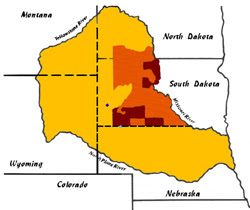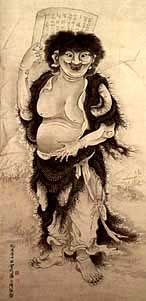by Bernie Quigley for The Free Market News Network at 12/28/07
 "It may be that some little root of the sacred tree still lives," Black Elk.
"It may be that some little root of the sacred tree still lives," Black Elk.
Of all the garden variety secession movements springing up today in North America, from Quebec Nation to the Republic of Texas and up to the Bear Republic of California then back again to Vermont and the Free State initiative here in New Hampshire, Lakota Nation is perhaps the most interesting.
The Argus Leader of Sioux Falls, South Dakota, reports that Lakota Indians, led by activist Russell Means, announced a plan recently for their people to withdraw from treaties their forefathers signed with the U.S. government. Lakota Nation seeks recognition for their effort to form a free and independent Lakota nation. The new nation is needed, the report said, because Indians have been "dismissed" by the United States and are tired of living under a colonial apartheid system.None of these initiatives have a change of success unless
Lakota always was and will continue to be when the white fellow with his city shoes and puffy L.L. Bean jacket succumbs with the loss of his hedge fund, derivatives and pension plan pegged to the falling dollar. Already he has no cousins or aunties. His religion is a dictatorship. His house is square and made of glass.
puffy L.L. Bean jacket succumbs with the loss of his hedge fund, derivatives and pension plan pegged to the falling dollar. Already he has no cousins or aunties. His religion is a dictatorship. His house is square and made of glass.
Lakota spirit lives in a round house, and as Black Elk said, Lakota lives therefore, “like the birds.” Lakota spirit will always be and it is everywhere. We name cars after it and states and movie stars. We call the name of Indian warrior spirit in battle. And most real Americans who have lost the Euro history like to claim to being "part Indian."
And Lakota Nation is, as Black Elk, the great Lakota shaman and prophet said, pointing north, “. . . the center of the world.”
Today, we see a reversal of Kipling’s maxim: East is East and West is West and never the twain shall meet. Now, East and West, like the recently-photographed galaxy known as IC2163, swinging counterclockwise past its celestial partner NGC2207, appear to be about to form into one unified solar system. Now they cannot be kept apart. It almost appears as if history was waiting for this moment to bring these two forces together in unity. An ancient spiritual force from the East and a new-to-history technical force in the West, as the Dalai Lama generally expressed it recently.
galaxy known as IC2163, swinging counterclockwise past its celestial partner NGC2207, appear to be about to form into one unified solar system. Now they cannot be kept apart. It almost appears as if history was waiting for this moment to bring these two forces together in unity. An ancient spiritual force from the East and a new-to-history technical force in the West, as the Dalai Lama generally expressed it recently.
These two forces could not have come together at any other time in history. Nor could they have flowed together into a unique new culture at any place other than the North American continent.
 Great Spirit, into
Great Spirit, into
This is the Aquarian mandala, which will find creative energy in centuries ahead. This means the development and enrichment of regional cultures on the North American continent, forging one another, helping one another and hating one another; forming new dynamic relationships and creating a new world.
We come together in a federalist state. With federalism, everyone is equal, but no one is connected. This is the Hamiltonian model of federalism and it is singularly responsible for how we have developed since 1776.
As Revelation closes the gate for one epoch which began its historical march in Rome and
 Christian pilgrim sought a life of the highest integrity and moral perseverance in a world torn asunder in the 1600s, so Frazier speaks to us today in Cold Mountain. There are two
Christian pilgrim sought a life of the highest integrity and moral perseverance in a world torn asunder in the 1600s, so Frazier speaks to us today in Cold Mountain. There are two Like Natty Bumpo, Frazier's hero finds wholeness and completion in the house of the Indian. It is the oldest and youngest of American stories. And it speaks well of the North American journey, a journey for all here which is just beginning.
The rabbis tell us that the gods hide in the lowest places. When I was a child we were told a story about a Texas lawman who died in the desert and was brought back to life - "born again" - by an Indian shaman. But he could not remember his name. He lost his history. And he no longer had Jesus but an Indian to guide him in the desert between East and West.
Each week we white folk were asked the important question: "Who is the Masked Man?"
We are the Masked Man. Our identity not yet revealed, even to ourselves.
2 comments:
Post a Comment